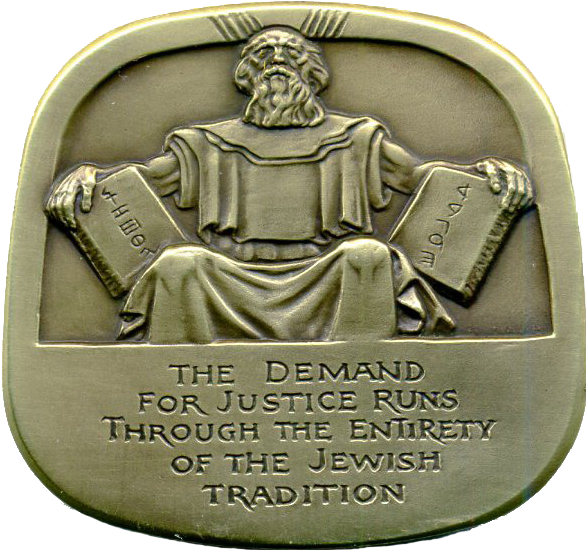 |  |
Ruth Bader Ginsburg medal designed by Eugene Daub, struck by the Highland Mint in quantities of 100 bronze, 55 pure silver, and 27 gold-plated silver. Portrait, JUSTICE RUTH BADER GINSBURG, DAUB. Reverse: Moses with Ten Commandments (after Hermon MacNeil), THE DEMAND FOR JUSTICE RUNS THROUGH THE ENTIRETY OF THE JEWISH TRADITION. 49 x 47 mm.
When Ruth Bader Ginsburg was appointed by President Bill Clinton and sworn in as the 107th justice to the United States Supreme Court on August 10, 1993, she became the second woman justice and the first Jewish woman ever to sit on the Court.
The Ginsburg medal crowns a year of impressive achievements for sculptor Eugene Daub, who previously attended the dedication of his statue of Rosa Parks in the National Statuary Hall in the United States Capitol — the first full-sized statue authorized and funded by Congress since the 1870s.
The reverse of the medal features Moses, holding the Ten Commandments, represented by the first ten letters of the ancient Hebrew alphabet. The great lawgiver is based on a sculpture by Hermon MacNeil in the eastern pediment of the Supreme Court Building. Inscribed is an extract from Ginsburg’s remarks when she received the Albert D. Chernin Award given annually by the Jewish Council for Public Affairs: “I am a judge, born, raised, and proud of being a Jew. The demand for justice runs through the entirety of the Jewish history and Jewish tradition.
Ruth Bader Ginsburg was born in Brooklyn on March 15, 1933. She was an excellent student in school, and was confirmed with honors by the East Midwood Jewish Center. At James Madison High School, she played the cello in the orchestra, was a member of Arista, was a cheerleader and a baton twirler, and the school newspaper editor.
One of only nine women at Harvard Law School, Ginsburg and her female classmates were asked by the dean why they were occupying seats that would otherwise be filled by men.
After transferring and graduating (tying for first in her class) from Columbia Law School, Ginsburg became the second woman to join the faculty of Rutgers Law School. When she discovered that her salary was lower than that of her male colleagues, she joined an equal pay campaign with other women teaching at the university, which resulted in substantial increases for all the complainants. Prompted by her own experiences, Ginsburg established the ACLU Women’s Rights Project in 1972 so that “artificial barriers are removed, and avenues of opportunity [are] held open to women.
The National Women’s Hall of Fame sums up Ginsburg’s service on the Supreme Court as: “Justice Bader Ginsburg has become known for her scholarly, balanced opinions and forthright personal courage.”